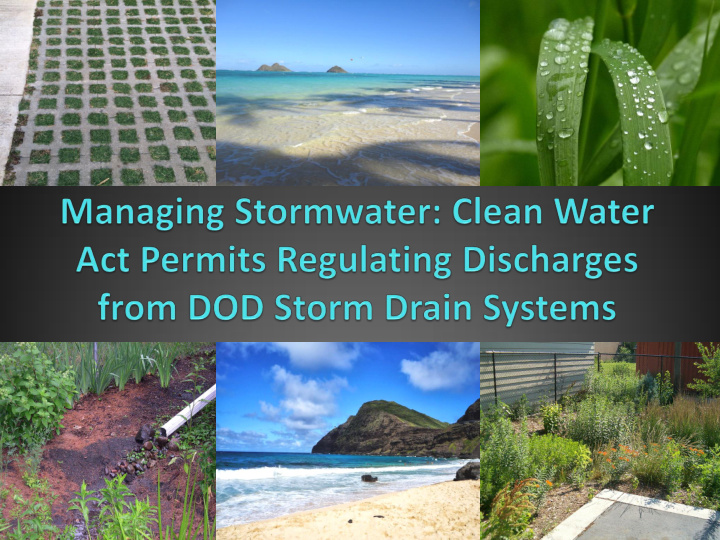



Why Stormwater Matters When it rains on Oahu, stormwater picks up debris, chemicals, sediment and other pollutants. The stormwater flows into a storm sewer system, where it is discharged untreated into streams and coastal waters. Pollutants in streams and coastal waters affect water quality. They destroy aquatic habitats and cloud the water, cause algal blooms, contribute bacteria and other pathogens to recreational waters, as well as deposit debris and hazardous materials like solvents, paint, motor oil, or pesticides. Urban impervious surfaces speed up and direct the flow of stormwater into the storm sewer system, which prevents it from being absorbed into and filtered by the ground.
Hawaii’s Water Quality According to DOH’s 2012 State of Hawaii Water Quality Monitoring and Assessment Report, of the 310 marine waterbody segments surveyed statewide, 225 were Oahu impaired for various pollutants. Total Waterbody Segments Assessed The most common cause of impairment listings in marine waters Impaired was turbidity, caused in large part by Statewide Marine polluted runoff. Waterbody Segments 0 100 200 300 400 On Oahu, 73 of the 134 marine segments assessed (54%) were impaired.
Clean Water Act: MS4 Permits Stormwater in urbanized areas is regulated through the Clean Water Act’s (CWA’s) NPDES program via Municipal Separate Storm Sewer System (MS4) permits. An MS4 is a publicly-owned system of conveyances that is used to collect stormwater that discharges to waters of the U.S. MS4 stormwater discharges are considered point sources under the CWA. The CWA’s MS4 permits are designed to control and prevent stormwater from discharging harmful pollutants into streams, lakes, and coastal waters. Army Garrison Hawaii, Department of Public Works and NAVFAC, are covered by State issued NPDES MS4 permits
DOD Covered Storm Drain Systems Army Garrison Hawaii MS4 Permit includes requirements for: Schofield Barracks, Wheeler Army Airfield, Fort Shafter, Aliamanu Military Reservation and may be modified to include other non-listed Army installations. NAVFAC is responsible for stormwater discharges from: Joint Base Pearl Hickam, Lualualei Naval Installation and Marine Corps Base Hawaii.
MS4 Permits Require Programmatic Minimum Control Measures All permits have them… Pollution Prevention/Good Housekeeping Illicit Discharge Public Involvement/ DOD Elimination (IDDE) Participation Storm Drain System Construction Site Public Outreach/ Runoff Control Education Post Construction Runoff Control Stormwater management requires an integrated approach to environmental compliance
Stormwater Permit Compliance Timeline • Over the next 12-18 months, the NPDES MS4 permitted installations will be required to develop and implement updated stormwater management programs. • All programs will have common elements and there is an opportunity for sharing and an economy of scale between services. • In 2-4 years, each program will likely be audited for permit compliance. Currently, Army Garrison Hawaii and NAVFAC have either been issued Administrative Actions for Permit non- compliance or may be issued one in the near future.
Going Forward: Stormwater Management in Hawaii Stormwater management is a key part of an integrated approach to sustainable communities that is consistent with Federal and State goals DOD MS4 permits provide a variety of opportunities to lead the way in efficient and effective environmental management that would allow it to serve as a model for urban and industrial areas throughout the state.
For More Information, Contact: Clean Water Branch 919 Ala Moana Blvd., Rm. 301 Honolulu, Hawaii 96814-4920 Phone: 808-586-4309 Fax: 808-586-4352 Email: cleanwaterbranch@doh.hawaii.gov http://health.hawaii.gov/cwb
Recommend
More recommend